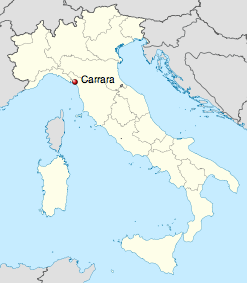Italian Marble
What are the physical properties that make it right for your home?
 Perhaps the most famous of the marbles is from the Carrara region of Italy. Used by Michelangelo, Donatello and Canova in their sculptures, Carrara marble was always chosen for its purity and durability. Calacatta and Statuario, in all their different forms (and there are many of them), are more of the Italian marbles from this region, similarly admired for their white colour. (By the way, "Carrera" is a Porsche and "Carrara" is the Italian marble.)
Perhaps the most famous of the marbles is from the Carrara region of Italy. Used by Michelangelo, Donatello and Canova in their sculptures, Carrara marble was always chosen for its purity and durability. Calacatta and Statuario, in all their different forms (and there are many of them), are more of the Italian marbles from this region, similarly admired for their white colour. (By the way, "Carrera" is a Porsche and "Carrara" is the Italian marble.)
In our experience, Italy has many of the best marbles in the world, having stood the test of time in some of the most famous places in the world. For example, in the displays at the Vatican Museum, the Italian marble is of exceptional quality.
Italian marble has earned its reputation primarily because the quarries in Italy have access to some of the best raw material in the world. Secondly, Italian quarries have set the highest standards for quality control and everything from selecting and cutting the blocks to packaging and shipping is done with precision.
 So that you can better understand where to use Italian marble in your home, it helps to learn about how it is formed.
So that you can better understand where to use Italian marble in your home, it helps to learn about how it is formed.
Marble has also been known as “crystallized limestone” because this is exactly how it is formed. When the sedimentary rock (limestone) is subject to a high temperature and immense pressure, large crystals form and bind together to create the metamorphic rock, marble. In marble however, we do not see the fossils in the same way that we would in limestone as the heat needed to form the crystals means that most of the impurities (fossils) are destroyed. So you are left with large sections of white marble with a varying degree of coloured ‘veins’ running through it which depends on the type of minerals present in the rock; this naturally varies depending on the original location of the marble, giving a uniqueness to each and every one.
 The intense heat and pressure in the earth's core and the consequent formation of large crystals means that marble is harder and more durable than the limestone it originated from. This makes it an ideal choice for any areas of your home that are in frequent use, such as kitchens, bathrooms and hallways. Marble has been used for centuries not only in construction but in art too, for statues and vases for example, thanks to it resilient nature. Marble can be polished to give a high shine due to the way that light reflects off of the large, pure crystals. A simple sheet of polished marble with its exquisite veining can, in its own right, be a work of art produced by nature.
The intense heat and pressure in the earth's core and the consequent formation of large crystals means that marble is harder and more durable than the limestone it originated from. This makes it an ideal choice for any areas of your home that are in frequent use, such as kitchens, bathrooms and hallways. Marble has been used for centuries not only in construction but in art too, for statues and vases for example, thanks to it resilient nature. Marble can be polished to give a high shine due to the way that light reflects off of the large, pure crystals. A simple sheet of polished marble with its exquisite veining can, in its own right, be a work of art produced by nature.
The fact that marble is generally more durable than limestone does not mean, however, that it is indestructible. It requires a little awareness of what can damage it.
Let's start by pointing out that staining should not be a problem. If you have seen our blog on sealing and cleaning, you will understand that a good quality sealer, such as MP90, Fob or MP90 Eco Plus, all made by the Italian stone-care company Fila, will protect the marble from water and grease-based stains.
Marble and limestones are subject to physical attack from acids, though. Lemon juice or other acidic liquids can cause etching in the surface of a polished stone. It is possible to slow down the action of the acid by applying a good quality wax such as Fila Classic after the stone has been sealed. This will buy a little time to give you an opportunity to wipe up a spillage before it does any damage but don't leave it for too long.
 This is a consideration when choosing a marble kitchen worktop and it is wise to be aware of the risk. Using a honed surface rather than a polished one will reduce the visible impact of etching and so, much of the marble that we supply as kitchen islands or worktops is honed rather than polished.
This is a consideration when choosing a marble kitchen worktop and it is wise to be aware of the risk. Using a honed surface rather than a polished one will reduce the visible impact of etching and so, much of the marble that we supply as kitchen islands or worktops is honed rather than polished.
For an example of how Italian marble would work in other areas of your home, why not see our blog on black and white Victorian style marble floor tiles.
Our brochure contains a case study showing how we found the perfect Italian marble for one of our customers. Can we help you find your perfect stone? Download the brochure and take the first step:
If you are thinking of using Italian Marble in your next project and would like to know more,
speak to Steve or Denise on 0345 260 8070
Did you find this useful or interesting?
If so, sign up to receive our next blog directly into your inbox by adding your email address in to the box at the top right of this page.


